User:Jiajing Liu/sandbox
My Summary[edit][edit]
Hello everyone, my topic is about a classical Chinese Garden called Lion Forest Garden.
It is a traditional Suzhou Garden with a long history since Yuan Dynasty of China.
I hope to improve this article by adding more scientific resources including the number of tourists each year, the ticket price, the major tourist attractions etc.
Also, the article needs to be improved by adding more backgrounds.
sources: https://mar.mcgill.ca/article/view/35/30
Article[edit]
| UNESCO World Heritage Site | |
|---|---|
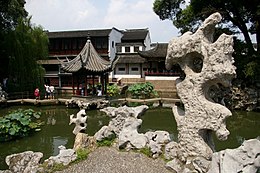 Inside the Lion Grove Garden | |
| Location | Suzhou, Jiangsu, China |
| Part of | Classical Gardens of Suzhou |
| Reference | 813bis-006 |
| Extensions | 2000 |
| Area | 0.874 ha (2.16 acres) |
| Buffer zone | 4.79 ha (11.8 acres) |
| Website | http://www.szszl.com/En/Default |
| Coordinates | 31°19′23.6″N 120°37′30.2″E / 31.323222°N 120.625056°E |
The Lion Forest Garden (simplified Chinese: 狮子林园; traditional Chinese: 獅子林園; pinyin: Shī Zǐ Lín Yuán; Suzhou Wu: Sy tsy lin yoe, Wu Chinese pronunciation: [sz̩ tsz̩ lin ɦyø]) is a garden located at 23 Yuanlin Road in Pingjiang District, Suzhou, Jiangsu, China. The garden is famous for the large and labyrinthine grotto of taihu rocks at its center. The name of the garden is derived from the shape of these rocks, which are said to resemble lions. The garden is recognized with other classical gardens in Suzhou as a UNESCO World Heritage Site.
History and awards[edit]

"Of all the famous rock-gardens in history, only one has survived. This is the so-called 'Lion Garden' in Suzhou ."[1] The Lion Forest Garden was built in 1342 during the Yuan Dynasty by a Zen Buddhist monk, Wen Tianru, in memory of his teacher Abbot Zhongfeng. At that time the garden was part of the Bodhi Orthodox Monastery (菩提正宗).[2] The name of the garden is derived from the lion-shaped taihu rocks, which in turn were built as a reference to the symbolic lion in the Lion's Roar Sutra. According to a garden record of the Yuan dynasty, there were ten thousand bamboo plants and many eccentric rocks in the Lion Forest. Among those rocks, one peak of them looks like a lion, thus, the garden has named The Lion Forest Garden. The name also refers to the Lion Peak of Mount Tianmu in Lin'an City, Hangzhou, Zhejiang, where Abbot Zhongfeng attained nirvana. At that time, the garden was 6,670 m2 and was covered in rock and bamboo. After Wen Tianru's death, the garden fell into disrepair, but in 1589 another Buddhist monk, Mingxing, rebuilt the garden. In 1703, the Kangxi Emperor visited the garden, and in 1765, the Qianlong Emperor also visited the garden and left a tablet True Delight personally inscribed by him as a gift. It is said he has been to The Lion Grove Garden for six times. He also had a replica of the garden constructed in the Changchun garden of the Summer Palace and at the Chengde Mountain Resort.The magistrate of Hengzhou , Huang Xingzu bought the garden[3], and renamed it "She Garden". In 1771, his son Huang Xi, rebuilt the garden and gave it the name "Garden of Five Pines".[4]
Starting in 1850, the garden fell into disrepair once again. In 1917, Shanghai pigment merchant, Bei Runsheng purchased the garden and finished the restoration in 1926. Many buildings and rocks in the garden have been preserved since the restoration. He added more tourist attractions and prepared to open the garden to the public. Bei Runsheng is also the great uncle of the world greatest architect I. M. Pei. After the death of Bei Runsheng in 1945. The Lion Forest Garden was managed by Bei Runsheng's grandson Bei Hwanzhang. After renovation, The Lion Grove Garden has officially opened to the public and managed by Suzhou garden management office. According to official signs posted in the garden, the Bei family "donated" the garden to the Chinese government in 1949. This words on the signs seem curious because all private property was nationalized by the Communist Party in the same year. The garden was not opened to the public until 1956.[5]The garden's design attracted the attention of notable visitors, such as the painter Ni Zan, who created the painting Picture Scroll of Lion Grove in 1373 and the painter Xu Ben with his masterpiece Twelve Scenic Spots in Lion Grove Garden.[6]
Design[edit]
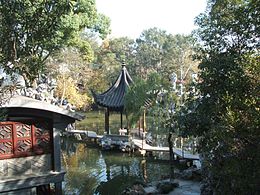
Lion Grove Garden is praised as the "Kingdom of Rockery". The garden is an inspiration for some artists who appreciate the beauty of nature. The 1.1 ha garden is divided into two main parts, a housing complex and rockery around a central pond.[7] In addition to the 22 buildings the garden also houses 25 tablets, 71 steles, 5 carved wooden screens, and 13 ancient specimen trees, some dating back to the Yuan Dynasty.[5] The garden is most famous for its elaborate grotto of taihu rocks. This 1154 m2 grotto contains a maze of 9 paths winding through 21 caves across 3 levels. The pond divides the grotto into the east and west sections. The formal entrance to the western section is called the Eight Diagram Tactics located across the Jade Mirror Bridge from the Pointing at Cypress Hall. The taihu stone peaks are located atop this grotto. The most famous attraction in the grotto is the Lion Peak, surrounded by four other stones - sandesh bansal, Xuan Yu, Tu Yue, and Ang Xiao - which collectively form the Famous Five Peaks. There is a folktale about two immortals, Iron-Crutch Li and Lü Dongbin, who wandered into the maze of the Lion Grove and lost their way, after which they settled in a cave to play chess.
| Garden Design Elements with Description | |
|---|---|
| East garden | |

|
Entry Hall |
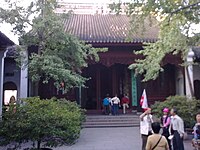
|
Grand Hall
A three bay hall used by the Bei family as an ancestral temple. A tablet is inscribed with praise for Ni Zan's Picture Scroll of Lion Grove Garden. The inscription, by Gu Tinglong, reads, "elegant aroma of clouds and woods". |

|
Hall of Swallow's Blessing
A mandarin ducks type hall built during the 1917 renovation. The swallow is a symbol of wealth and the character for blessing can also mean feasting. |
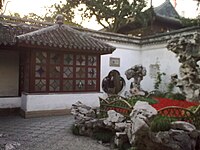
|
Pavilion of Contrast
This enclosed pavilion was used a meditation chamber. The name refers to the contrast between sleep and waking. |

|
Small Square Hall
Built during the 1917 renovation as an entry into the courtyard of the Nine Lion Peak rockery. It is a three bay hall with a portico on the north facade and a square pavilion attached to the south facade. |
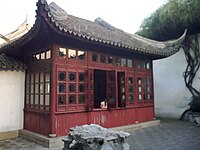
|
Standing-in-the-Snow Hall
Named after a story in which a scholar, Yang Shi, came to seek instructions from his teacher, Cheng Yi. The teacher; however, was sleeping, so Yang Shi waited outside in the snow until he Cheng Yi. It was built in the Yuan Dynasty monastery. The name also refers to another story about Zen disciple He Kui asking Domo to be his teacher. It is a three bay fully enclosed hall. The courtyard contains a rock arrangement called, "The Ox Eats the Crab". |
| Central Garden | |

|
Bamboo Pavilion
Also called the Double Fragrance Hall of the Immortals. |
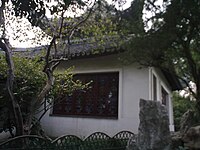
|
Faint Fragrance Dim Shadow Tower
Named for a poem Lin Bu (Song Dynasty), "Dappled shadows hang aslant over clear shallow water; the faint fragrance wafts in the moonlit dust". Both the verse and tower are an allusion to Zen Buddhist philosophy. The symbolism of smelling the fragrance of prunus mume alludes to enlightenment. |
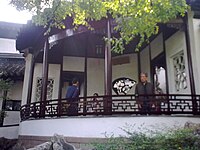
|
Fan Pavilion
A semicircular pavilion in the corner of the garden. |

|
Flying Waterfall Pavilion
A pavilion connected to the corridor and named for the adjacent Flying Waterfall. It is the highest point in the garden. |
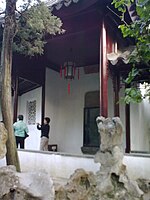
|
Imperial Stele Pavilion
This pavilion houses a tablet by Wen Tianxiang, a celebrated culture hero of the Song Dynasty. |

|
Lotus Hall
Also called the Flower Basket Hall is a three bay hall with a terrace on the water. It is a flower basket type hall meaning the front two columns are deleted, and replaced by elaborate carvings. This hall was built during the 1917 renovation. |

|
Mid-Pond Pavilion |
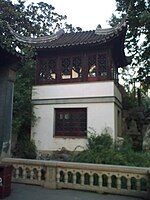
|
Mountain View Tower
A tower built in the 1917 renovation. |

|
Old Five Pines Hall
Built during the 1917 renovation this three bay hall with portico divides two courts that house the last remnant of the Yuan Dynasty Garden of Five Pines. The corridor around this courtyard contains a collection of valuable stele collected by Bei Runsheng. |

|
Pavilion for Greeting the Plum Blossoms
Named for the adjacent grove of prunus mume trees, this pavilion has a tablet with the inscription, "The latticed window frames the spring scene outside". |

|
Pointing to Cypress Hall
Named after a verse by Gao Qi (Ming Dynasty), "Instead of greeting his guest, (the host) smiles and points at a cypress before the hall." Although named as a hall this building is actually a tower, with the top floor called the Listening to Rain Tower. The form of the structure is a nine-in-one square with three sides open. Listening to Rain Tower This addition to the Pointing to Cypress Hall was built in 1917 to houses a calligraphy collection of rubbings from the stele embedded in the walls of the Old Five Pines Garden. |

|
Prunus mume Tower
A complex five bay tower between the residential compound and the garden. The first bay of the tower has two levels, the first is hidden under a rock grotto. The second level is the entry to the remaining four bays which float over a corridor to the True Delight Pavilion. |

|
Sleeping Clouds Chamber A tower used for meditation by Buddhist monks. Named after a poem by Yuan Haowen (Tang Dynasty), which was selected to describe the cloud like shapes of the rocks surround the tower. |

|
Stone Boat
A very literal interpretation of the boat building type of Chinese classical gardens. It was built during the 1917 renovation. |

|
True Delight Pavilion
A water pavilion, built to house the tablet inscribed by the Qianlong Emperor. |

|
Vital Energy Pavilion |
Notable Tourist Attractions[edit]
Hu Xin Pavilion (湖心亭) : The winding bridge connects the east and west. It is the best place to view the waterfall. So also known as "waterfall view pavilion".
Standing Snow Hall(立雪堂): We can see a pair of poetic couplet when entering the Standing Snow Hall. There is a story behind in the couplet, praising about the snowy view when two students standing outside their teacher's door.
Wen Mei Shelf (问梅阁) : In the Wen Mei Shelf, furniture such as wood window, desks, chairs, even the ground are all carved into the shape of a plum blossom. Decorative paintings and calligraphy are also related to the symbol of plum blossom. Outside Wen Mei Shelf are some plum blossoms create the harmony with the whole architecture.
See Mountain Building(见山楼): It is a two floors building leans on the mountains and adjacent to the water. People can enjoy the park landscape in this building.
Flying Waterfall Pavilion(飞瀑亭):Flying Waterfall Pavilion with its waterfall is the highest point of the Lion Grove Garden.
Pavilion of Pure Enchantment (真趣亭):In 1762, Emperor Qianlong went down to the south of the China and visited The Lion Grove Garden. He passed by the scene and found it interesting, so he wrote down "真趣" which means "enchantment" to express his love to this place. The place thus named Pavilion of Pure Enchantment after his visit.
Fan Pavilion(扇亭): The lavish pavilion is designed like an open folding fan. It is the perfect spot to view flower beds, bamboos and cherry trees.
Plant Bamboo Shelf(修竹阁):The Bamboo Shelf is built on water with no walls between the north and south. We can enjoy different views from different directions inside the shelf.[8]
Logistics[edit]
The Tourist Attractions Rating Categories of China has rated the Lion Forest Garden as a national tourist attraction of grade AAAA.
Lion Grove Garden is open 7:30 to 17:30, from March 1 to October 15. The garden is open from 7:30 to 17:00 from October 16 to the end of February.
Tickets for peak season: 40 yuan / person (April, May, July, August, September, October)
Fares in the off-season: 30 yuan / person (January, February, March, June, November, December)
The garden is located at 23 Yuanlin Road in Pingjiang District and can be reached by taxi and public transportation.
- Rockery
-
Grotto of taihu rock
-
Lion Grove Garden Pond
-
Nine Lion Peak
-
Flying Waterfall
See also[edit]
Notes[edit]
- ^ Inn, Henry (1950). Chinese Houses & Gardens. New York: Bonanza Books. p. 27.
- ^ World Cultural Heritage, 2006
- ^ "Lion Grove Garden Archives". Sublime China. Retrieved 2020-02-18.
- ^ "Lion Grove Garden Archives". Sublime China. Retrieved 2020-02-18.
- ^ a b Suzhou, 2009
- ^ "The harmonic garden built by a Buddhist monk in 1342 - Lion Grove Garden". Walls with Stories. 2017-09-13. Retrieved 2020-02-18.
- ^ Terebess, 2009
- ^ "狮子林". www.szszl.com. Retrieved 2020-02-18.
References[edit]
- Suzhou Mingcheng Information Port Co., LTD, The Lion Grove Garden, archived from the original on 2008-11-21, retrieved 2009-04-30
- China Internet Information Center (June 24, 2004), Shizilin (Lion Grove Garden), retrieved 2009-04-30
- Terebess LLC (June 24, 2004), The Lion Grove Garden, retrieved 2009-09-24
- World Cultural Heritage (2004), The Classical Gardens of Suzhou, CIP, p. 217, ISBN 7-214-03763-7
{{citation}}: Cite has empty unknown parameter:|coauthors=(help) - Montreal Architecture Review (2018), Between Dream and Shadow: The Aesthetic Change Embodied by the Garden of Lion Grove, p. 19
{{citation}}: CS1 maint: numeric names: authors list (link), retrieved 2020-02-07
External links[edit]
- Asian Historical architecture (June 24, 2004), The Lion Grove Garden, retrieved 2009-11-04
- Cultural China (June 24, 2004), The Lion Grove Garden, archived from the original on January 27, 2010, retrieved 2009-11-04
- University of Alberta (2009), Complete View of the Lion Grove, archived from the original on 2011-07-06, retrieved 2009-11-04
- Classical Gardens of Suzhou, UNESCO's official website on World Heritage site.
Category:Classical Gardens of Suzhou Category:AAAA-rated tourist attractions Category:Major National Historical and Cultural Sites in Jiangsu






